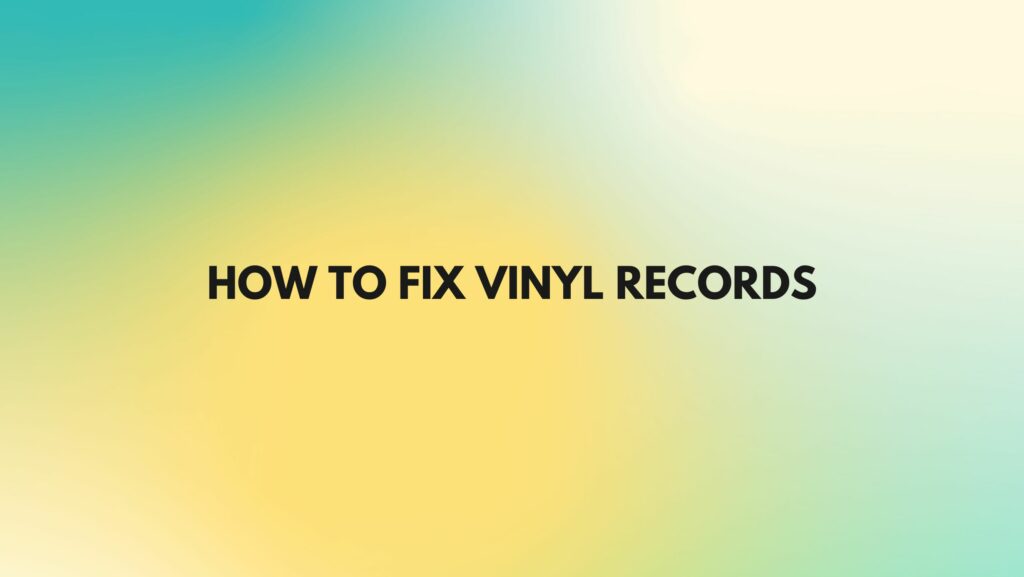Vinyl records, cherished for their analog warmth and rich sound quality, can sometimes suffer from wear and damage over the years. Scratches, dust, and other imperfections can affect the listening experience. However, many issues can be addressed, allowing you to restore and enjoy your vinyl collection. In this comprehensive article, we will explore various methods to fix vinyl records, from cleaning to more advanced repair techniques.
- Cleaning Vinyl Records
Proper cleaning is essential for maintaining and restoring the sound of vinyl records. Here are some steps to effectively clean your records:
a. Supplies: Gather the necessary supplies, including a carbon fiber brush, an anti-static brush, a microfiber cloth, distilled water, and a cleaning solution specifically designed for vinyl records.
b. Preparation: Start by removing dust and loose particles from the record’s surface using a carbon fiber brush. Gently brush the surface in a circular motion to avoid pushing debris into the grooves.
c. Wet Cleaning: For a deeper clean, use a record cleaning solution. Apply a small amount of the solution to a microfiber cloth or specialized cleaning brush and wipe the record surface in the direction of the grooves. Be gentle and avoid using excessive pressure.
d. Rinse: Wipe the record with a clean, damp cloth using distilled water to remove any remaining cleaning solution. Make sure the record is completely dry before playing it.
- Repairing Scratches
Scratches on vinyl records are a common issue and can affect sound quality. While deep scratches may be challenging to repair, minor scratches can often be improved with these methods:
a. Wood Glue Method: Apply a small amount of wood glue to the scratched area, spreading it evenly. Let it dry completely, and then peel it off. This can sometimes remove debris from the scratch.
b. Vinyl Repair Kit: Invest in a vinyl repair kit, which typically includes a fluid designed to fill in minor scratches. Follow the kit’s instructions for application and drying.
c. High-Quality Stylus: Using a high-quality stylus with a fine elliptical or microline tip can help reduce the impact of surface scratches on sound quality.
- Removing Static and Pops
Static and pops are common nuisances when playing vinyl records. Reducing static and pops can enhance the listening experience:
a. Anti-Static Brush: Use an anti-static brush to remove static charge from the record before playing. These brushes have conductive bristles that discharge static electricity.
b. Cleaning Solution: Applying a static-reducing cleaning solution can help minimize static buildup. These solutions can be applied before each play.
c. Record Cleaning Machines: For a more thorough solution, consider investing in a record cleaning machine, which can clean and reduce static on multiple records.
- Handling Warped Records
Warped records can result from improper storage or exposure to heat. While extreme warping may be challenging to fix, minor warping can sometimes be resolved:
a. Heat and Pressure: Place the warped record between two sheets of glass or between the platters of two turntables. Apply gentle pressure and leave it in direct sunlight. The heat can help the record regain its shape over time.
b. Record Weight: Some turntables come with a record weight or clamp that can help flatten minor warps when the record is played.
- Seeking Professional Help
For more severe issues, such as deeply ingrained scratches or damaged grooves, it’s best to seek professional help. There are record restoration services and specialists who can repair and restore vinyl records. They may use advanced techniques such as groove-filling and fine-tuning to rescue damaged records.
Conclusion
Vinyl record restoration is a rewarding process that allows you to revive and enjoy your beloved vinyl collection. Regular cleaning and proper handling are essential for preserving records. For minor issues like scratches, static, and minor warping, DIY methods can often produce satisfying results. However, for more complex problems, seeking professional assistance is recommended to ensure the best possible outcome.
By investing time and care into your records and using the methods outlined in this article, you can enhance the longevity and sound quality of your vinyl collection and continue to savor the unique analog experience it offers.


